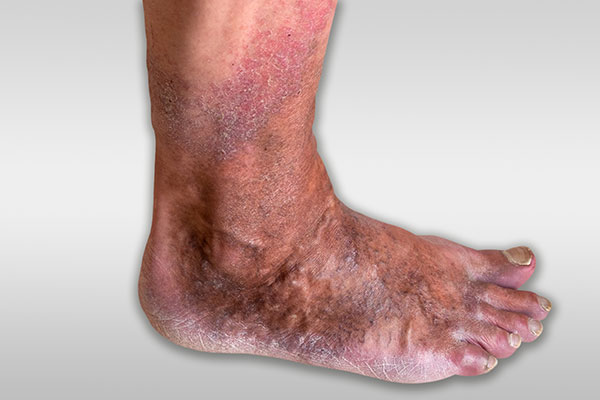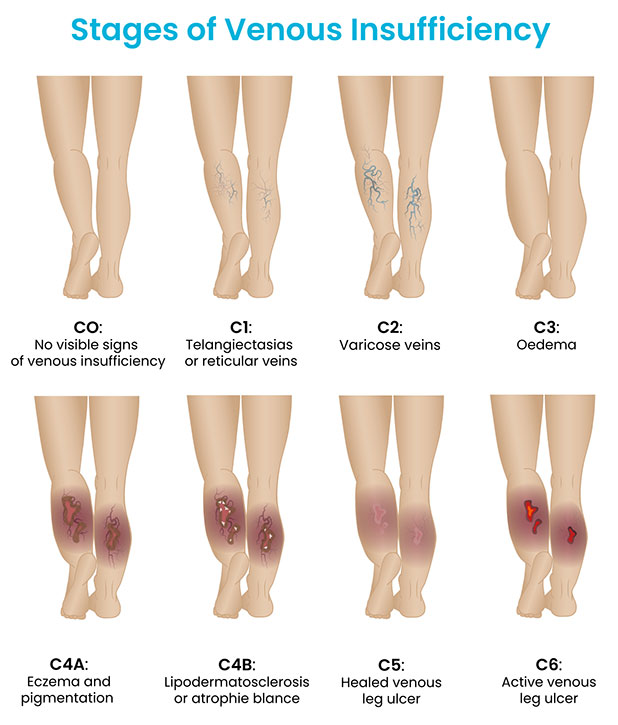What are the 8 Stages of
the CEAP Classification of Venous Insufficiency?
The CEAP Classification for venous insufficiency was first developed by the American Venous Forum (AVF) in 1994.[1]
The CEAP Classification offers a comprehensive and standardised tool to improve both diagnostic procedures and the management of a range of symptoms and conditions associated with venous insufficiency.[2]
What is venous insufficiency?
Venous insufficiency is a type of venous disease that occurs when the veins in the lower limbs are damaged and no longer function properly. Our arteries carry oxygen-rich blood from the heart to the rest of the body. The deoxygenated blood is then returned to the heart by the veins.
The legs play an important part in supporting the veins to perform this function through the calf pump mechanism. When we walk, the muscles in our feet and ankles contract, which squeezes the veins in our legs. This action moves the blood upwards toward the heart.
The calf pump mechanism is not enough to keep the blood flowing away from the legs against the force of gravity. The veins have small flaps of tissue known as valves. The one-way valves prevent the backflow of blood.
When the valves are damaged, they become incompetent. This means that they are unable to close properly and allow the blood to flow backwards. When this occurs, blood can begin to pool in the legs, especially around the ankles. This can result in swelling. This swelling is often accompanied by pain, cramping, and even ulcers.
Why is the CEAP Classification important?
Before the publication of the CEAP Classification, there was no codified system in place to classify venous disorders. The absence of a standardised classification system sometimes led to reporting problems and diagnostic inconsistencies. These two key issues often contributed to the mismanagement of venous insufficiency and its various symptoms.
The AVF recognised that it was necessary to correct the lack of diagnostic precision in the field of chronic venous insufficiency by creating a consensus document that was both detailed and broad.
The AVF sought to develop a classification system that resembled the TNM Classification used in prognostic cancer staging, which considers the tumour, nodes, and metastases.[3]
The CEAP Classification simultaneously identifies the symptoms and severity of venous insufficiency. Each stage of the classification maps out the progression of venous insufficiency. It begins with showing no noticeable symptoms of venous issues and ends with an active venous ulcer.[4]
The CEAP Classification is not intended as a standalone diagnostic tool. It works best as part of a wider, holistic assessment of the patient. This assessment should take into consideration the patient’s medical history, lifestyle, routine test results, and symptoms.
The tool is designed for each of the stages to be connected to specific management options. For example, an active venous leg ulcer should be linked to recommended treatments such as compression therapy and elevation.
On a wider scale, the tool is meant to improve communication about the different stages of venous insufficiency among healthcare professionals.
What are the CEAP stages of venous insufficiency?
C0
No visible signs of venous insufficiency.
C1
Telangiectasias or reticular veins.
C2
C3
Oedema.
C4A
Eczema and pigmentation.
C4B
Lipodermatosclerosis or atrophie blance.
C5
Healed venous leg ulcer.
C6
Active venous leg ulcer.[5]
What has changed since the publication of the CEAP Classification?
There have been some developments in the diagnosis and treatment of venous diseases since the CEAP Classification was first published. There is now more uniform language around venous insufficiency and improved testing to identify the signs and symptoms of the condition in its early stages.
Nevertheless, the number of patients whose initial symptoms are still improperly managed and progress into chronic venous leg ulcers remains high. In the UK alone, venous leg ulcers affect around 1 in 500 people.[6]
The CEAP Classification, however, was never intended as a static consensus document. It is meant to evolve and improve as new scientific developments and clinical feedback are received. There have been several iterations since it was first published, with the most recent being in 2020.
Each version of the classification builds upon the original 8-stage framework and expands on it. This is meant to provide an increasingly more detailed and precise description of the signs, symptoms, and severity of venous insufficiency to improve the management of the condition.
Despite the continuous need for improvement, the CEAP Classification remains one of the most important tools for staging venous insufficiency and is accepted worldwide.
References:
- Eklöf, Bo. Revision of the CEAP Classification for Chronic Venous Disorders: Consensus Statement. J Vasc Surg 2004; 40(6): 1248
- Ibid: 1248
- Zegarra TI, Tadi P. CEAP Classification of Venous Disorders. StatPearls 2022. Available from: https://www.ncbi.nlm.nih.gov/books/NBK557410/
- Eklöf, Bo. Revision of the CEAP Classification for Chronic Venous Disorders: Consensus Statement. J Vasc Surg 2004; 40(6): 1249
- Zegarra TI, Tadi P. CEAP Classification of Venous Disorders. StatPearls 2022. Available from: https://www.ncbi.nlm.nih.gov/books/NBK557410/
- Venous Leg Ulcer. NHS. 16 November 2022. Venous leg ulcer – NHS (www.nhs.uk)
Resources:
Product website:
Other related articles:
Disclaimer:
Please note that while every effort is made to ensure the accuracy of the content presented, it is purely for educational purposes only and is not a substitute for professional medical advice.



